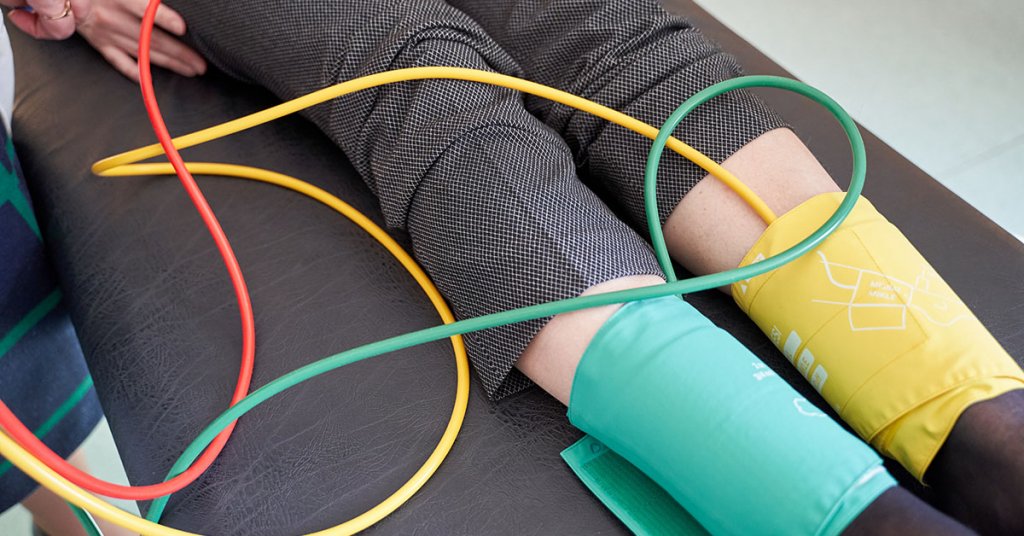6 Procedures Used for PAD Diagnosis & Treatment

Peripheral artery disease (PAD) is a condition in which blood flow to the limbs is slowed or stopped. The most common cause of PAD is atherosclerosis. Atherosclerosis is a condition in which the arteries are clogged by a buildup of scar tissue and cholesterol. According to the Centers for Disease Control and Prevention (CDC), about 8.5 million Americans over the age of 40 have PAD. Vascular specialists like interventional radiologists can perform several tests to make a PAD diagnosis. There are also several procedures that can be used to treat PAD.
Procedures Used for PAD Diagnosis
Ankle-Brachial Index Test
An ankle-brachial index (ABI) test is a simple and common way to make a PAD diagnosis. An ABI compares the blood pressure in your ankle to the blood pressure in your arm. These measurements can help determine how well your blood is flowing in your arms and legs. This test can be used to determine whether or not you have PAD and if it is affecting blood flow to your legs. However, further testing is needed to determine which arteries are blocked.
Vascular Ultrasound
Different types of ultrasound imaging can be used to help confirm a PAD diagnosis. Ultrasound technology uses sound waves to create images of the blood vessels. Often, duplex ultrasounds that use both Doppler and B-mode technologies to create images of the blood vessels as well as how blood is flowing within the vessels. Ultrasounds are a noninvasive way for doctors to view blood vessels and identify blockages.
Angiography
Angiography uses imaging technologies to create 3D images of blood in the arteries in the abdomen, pelvis, and legs. Before an angiogram, a contrast dye is injected into the arteries. The dye allows doctors to see how the blood is flowing through the arteries when using different imaging technologies. The two most common types of angiography include:
- Magnetic resonance angiography (MRA)
- Computerized tomography angiography
- X-ray angiography
Procedures Used for PAD Treatment
Angioplasty, Stent Placement, and Atherectomy
Angioplasty is a procedure that can be performed to treat PAD. It is less invasive than open surgery. Angioplasty is considered a lower risk and less costly than traditional open surgery. Recovery time after a less invasive procedure is usually shorter as well. Stent placement and atherectomy are often used in addition to angioplasty to achieve improved results.
Angioplasty is often performed when blockages are found during an angiogram, so the doctor will use the same access puncture they made for the angiogram to perform the angioplasty:
- Balloon angioplasty: A catheter is threaded through the puncture access in the groin, ankle or arm using imaging for guidance. When the catheter is in place in the blocked blood vessel, the interventional radiologist inflates a balloon to expand the blockage thereby increasing the blood flow.
- Angioplasty with stenting: When the balloon angioplasty doesn’t clear the blocked vessel well enough, a small metal cylinder called a stent may be placed to hold the blood vessel open.
- Atherectomy: Atherectomy is a procedure that is performed to treat peripheral artery disease caused by atherosclerosis. This procedure is minimally invasive and can be done on an outpatient basis using only local anesthesia. It is performed to clear plaque buildup on the interior walls of the arteries (vs expansion of the plaque through angioplasty). Atherectomy may be performed in several ways:
- Rotational atherectomy: Uses a special catheter with a special drill on the tip that rotates to grind away plaque.
- Directional atherectomy: Uses a small scalpel blade at the end of a catheter to cut plaque away from the artery.
- Laser atherectomy: A laser is used to remove plaque rather than a scalpel.
- Orbital atherectomy: Similar to rotational atherectomy, but uses a modified tip to remove plaque.
If you would like to schedule an appointment at Preferred Vascular Group to have a consult with a board-certified physician or would like to have one of our highly-trained care providers reach out to you, please click on a button below:
